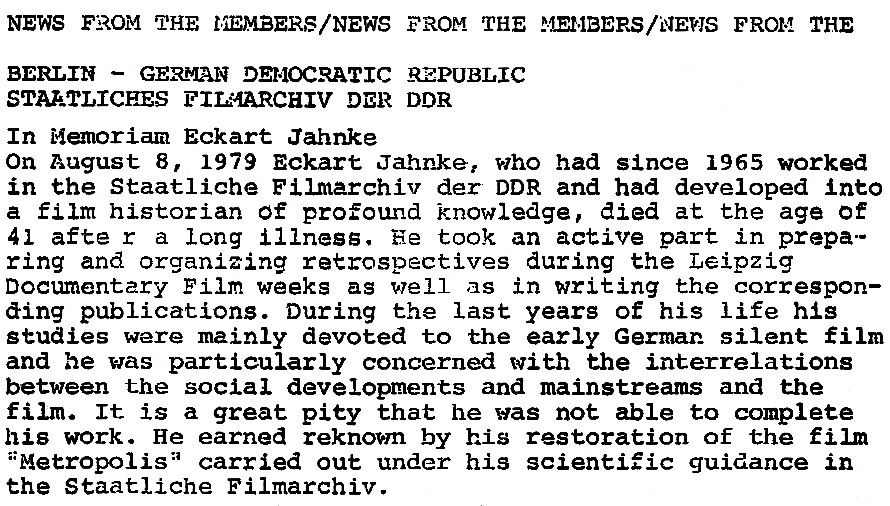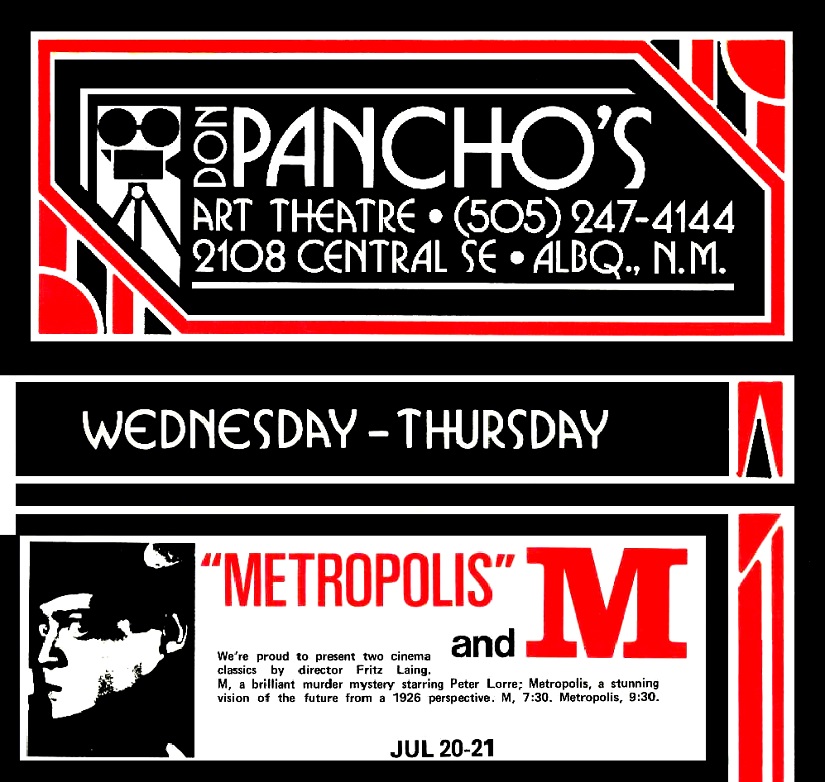| Return home |  |
Return to previous page |
July 1977: The Janus Edition Comes to Albuquerque
Metropolis intrigued me that Saturday night in May, and so I wanted to see it again.
A mere two months later, it played at Don Pancho’s.
I was expecting to see the same movie, though terribly cropped to widescreen and with three to ten seconds skipped at every change-over ,
because that’s how Don Pancho’s did things, always, always, always, always, always.
To my surprise, it was not the same movie at all.
It was the Janus
print, yes, but it was not what I had just seen on TV.
It was optically reduced to Academy 1:1.375, and so Donald Pancho’s cropping to 1:1.66 rendered much of the movie senseless.
The speed was noticeably different — much faster than what I had just seen on television a few months before.
When it was shown on PBS two months prior, it raced like mad.
Now it raced even more, but hey,
Fritz Lang and his composer Gottfried Huppertz wanted it faster yet, 26fps.
As Aitam Bar-Sagi documented, Gottfried Huppertz had handwritten notes on his score:
“93m = 186sek.”
Translated into British, that is 305.118' over 186 seconds.
Remember, there are 16 frames per foot of film, and so 305.118 = 4,881.888 frames, which we can call 4,882 frames.
Divide both sides by 186 and we get nearly 26¼ frames per second.
We can call that 26fps, or, better, we can call that just under 98½'/min.
Nothing was exact in the silent days.
Here is a thought that never crossed my mind:
“I wonder if any of these people are still alive.”
The movie was from a different era, and so I never even thought about it.
Yet Fritz Lang had just passed away less than a year previously.
Gustav Fröhlich and
Brigitte Helm were still around.
Had I learned that, I don’t know if it would have registered.
Our perceptions of time change drastically as we have more experiences and as we simply age.
My perception of time now does not in any way resemble my perception of time at age 17.
I knew that would happen, but I had no conception of what that really meant, nor could I have.
At age 17, knowing that Gustav and Brigitte were still alive would not have made me aware of a connection.
This was now and that was then, and the people they are now are not the people they were then,
and I just couldn’t make the connection.
Nowadays, I cannot make anything except that connection.
Yet now, at my current age, 1940 is very recent and 1963 is brand new,
but 1930 is a previous æon, no matter that I cannot help but identify with it.
My fallible memory, from my single viewing of a 35mm Janus print in the summer of 1977, is that it looked beautiful.
Crystal clear, bright, good blacks, excellent contrast, no graininess, no flicker, no blemishes.
It looked nearly as good as new.
Confession: I cannot remember a note of the music on the Janus Metropolis soundtrack.
I do remember that it was an orchestra,
and I do remember that it was unmemorable.
The music we heard on the Associated British preview above rings no bells, but that means nothing.
I need to watch the Janus edition again, but it has vanished from the face of the planet.
Though it was seen by numerous movie buffs in the 1970’s,
not a single person remembers its existence — except for me.
Somebody must have invented a magical machine that erases collective memory,
and that somebody must have chosen to test that machine by a trial run
targeting worldwide memories of the Janus edition of Metropolis.
Should you decide to mosey on over to NitrateVille, you will find
a query from a DSamuels90
who expressed interest in seeing what was available to Americans prior to the recent restorations.
Good luck!
What then follows in response can be summarized by a huge fat zero.
What DSamuels90 needs to see is the Paramount edition or the Janus edition, preferably both,
and those are two of the editions I so desperately would like to add to my collection.
If he can bicycle up to Toronto, he could possibly talk Reg Hartt into showing
his 16mm print of the eight-reel August 1927 Paramount edition.
As for the 94-minute 35mm and 16mm Janus edition,
it was as common as dirt in the 1970’s but then it evaporated. Bewildering.
There are some VHS tapes, including the 1989 Kino tape described above,
that approximate the MoMA prints that circulated for about a decade.

|
